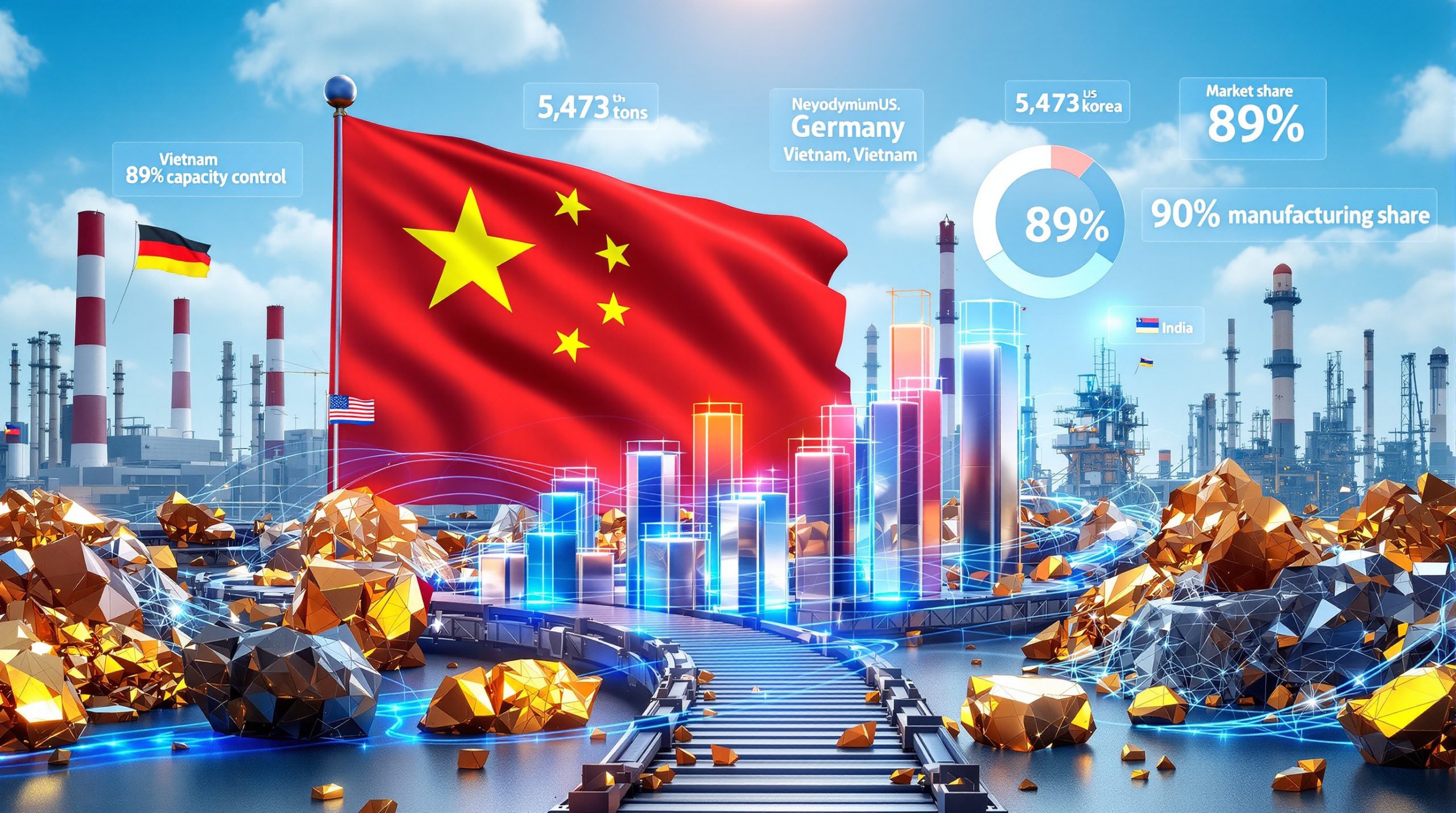Global Supply Chain Dependencies Shape Critical Mineral Market Dynamics
Modern industrial economies operate within complex networks of resource dependencies that extend far beyond traditional trade relationships. These interconnected systems create strategic vulnerabilities when single nations control essential raw materials required for advanced manufacturing processes. Understanding these dependencies becomes crucial as geopolitical tensions influence supply chain security across multiple sectors, particularly as governments implement new frameworks like the Critical Minerals Order.
The concentration of critical mineral processing capabilities in specific geographic regions reflects decades of industrial specialization and technological development. This concentration has created bottlenecks that affect everything from consumer electronics manufacturing to defense system production, making supply chain resilience a national security priority for many countries.
Current Chinese Rare Earth Magnet Export Performance
China's October 2025 china rare earth magnet exports reached 5,473 metric tons, marking a 5.2% decline from September's 5,774 tons, according to data from the General Administration of Customs. This represented the second consecutive monthly decrease, indicating potential shifts in export patterns or strategic inventory management decisions.
Despite the monthly decline, year-over-year performance showed resilience with 15.8% growth compared to October 2024's 4,725 tons. This growth trajectory suggests underlying demand strength persists despite short-term volatility in monthly shipment volumes.
Year-to-Date Export Trajectory Analysis
Through October 2025, cumulative china rare earth magnet exports totaled 45,290 tons, reflecting a 5.2% annual decline compared to the previous year's equivalent period. The data reveals that August 2025 achieved peak export performance, representing a seven-month high before the subsequent September and October declines.
Monthly Export Performance Overview:
• August 2025: Seven-month peak performance
• September 2025: 5,774 tons with moderate growth momentum
• October 2025: 5,473 tons showing policy uncertainty effects
• Year-over-year growth: 15.8% increase despite monthly volatility
The seasonal patterns indicate that china rare earth magnet exports may be influenced by both demand cycles in destination markets and strategic export management decisions aligned with policy objectives.
Regional Trade Flow Analysis and Market Positioning
United States imports of Chinese rare earth magnets surged dramatically in October 2025, reaching 656 tons and representing a 56.1% monthly increase from September levels. This volume marked the highest US import level since January 2025, suggesting potential strategic stockpiling behavior by American manufacturers.
Top Destination Markets for Chinese Exports
The five largest destination markets for china rare earth magnet exports by volume in October 2025 were:
- Germany – Industrial manufacturing hub driving consistent demand
- United States – Defense and technology sector applications
- South Korea – Electronics and automotive manufacturing requirements
- Vietnam – Expanding manufacturing base and supply chain integration
- India – Growing technology infrastructure development needs
This geographic distribution reflects the global nature of rare earth magnet applications, spanning from traditional industrial manufacturing in Germany to emerging technology infrastructure in Vietnam and India.
Strategic Stockpiling Implications
The 56.1% surge in US imports coinciding with overall Chinese export declines may indicate anticipatory purchasing behavior by American manufacturers. Defense contractors and technology companies potentially accelerated procurement timelines in response to ongoing trade policy uncertainties, particularly as nations develop comprehensive Critical Minerals Strategy frameworks.
The dramatic increase in US imports during a period of declining overall Chinese exports suggests strategic positioning by American manufacturers anticipating potential supply constraints.
Export Control Framework and Policy Architecture
Beijing's approach to rare earth magnet exports involves a complex regulatory structure that balances commercial interests with strategic policy objectives. The Ministry of Commerce oversees licensing requirements while maintaining flexibility to adjust restrictions based on diplomatic considerations, reflecting broader patterns in China's Export Controls.
Current Control Measure Timeline
Policy Implementation Schedule:
• December 2024: Super-hard materials export ban announced but subsequently suspended for one year
• April 2025: Seven key rare earth elements brought under active licensing requirements
• October 2025: Expanded content threshold policy implementation delayed by one year
• November 2025: Suspension of October controls announced as part of Busan summit commitments
The timing of these policy adjustments correlates with diplomatic engagement cycles, particularly the late October summit in Busan, South Korea, where Beijing pledged to de-escalate trade tensions with Washington.
Licensing System Architecture
The current export control system requires government approval for shipments of specified rare earth materials and finished magnets. This licensing framework creates administrative delays while providing Beijing with discretionary authority over export volumes and destinations.
Key Control Components:
• Ministry of Commerce approval requirements for specified materials
• Content threshold specifications affecting downstream manufacturers
• Technology transfer restrictions extending to international operations
• Penalty frameworks for compliance violations
Industry sources indicate that Beijing is designing modifications to the licensing regime that could streamline approvals while maintaining strategic oversight capabilities.
Global Supply Chain Vulnerability Assessment
The concentration of rare earth processing and magnet manufacturing capabilities creates systemic vulnerabilities across multiple industrial sectors. These dependencies extend beyond direct Chinese suppliers to include international manufacturers using Chinese raw materials or intermediate products.
Risk Classification Framework
Supply Chain Dependency Categories:
• High Risk: Direct Chinese material dependency exceeding 50% of supply requirements
• Medium Risk: Mixed sourcing arrangements with 25-50% Chinese component content
• Lower Risk: Diversified supply chains with less than 25% Chinese material dependence
The extraterritorial nature of some control measures means that third-country manufacturers using Chinese materials may require export licenses, extending Beijing's influence beyond its territorial boundaries.
Manufacturing Sector Impact Analysis
International manufacturers face compliance burdens that include documentation requirements, certification processes, and potential audit procedures. These administrative requirements create operational delays and increase production costs, particularly for companies with integrated supply chains spanning multiple countries.
Furthermore, the International Energy Agency notes that these supply concentration risks have become a reality, affecting global energy transition efforts.
Chinese Market Dominance in Rare Earth Production
China maintains overwhelming control over multiple stages of the rare earth supply chain, from initial extraction through finished magnet production. This vertical integration creates strategic leverage that extends across numerous technology sectors and defense applications.
Production Capacity Control Statistics
Chinese Market Share Estimates:
• Approximately 90% of global high-performance magnet manufacturing capacity
• Near 90% of global rare earth refining and separation capabilities
• Dominant position in specialized processing technologies and quality standards
This concentration reflects decades of industrial specialization, technology development, and government support for rare earth industries. The integrated nature of Chinese operations spans from mining through advanced manufacturing processes.
Strategic Bottleneck Identification
Critical Control Points:
• Raw material extraction and initial processing capabilities
• Specialized separation and purification technologies
• Advanced magnet sintering and manufacturing processes
• Quality certification and technical standards development
These bottlenecks create dependencies that affect industries ranging from renewable energy equipment manufacturing to defense system production, making supply chain diversification a strategic priority for many nations.
Industrial Sector Exposure and Vulnerability Analysis
The dependence on China's rare earth magnet exports affects multiple critical industrial sectors, each with distinct vulnerability profiles based on application requirements and substitution feasibility.
Defense and Aerospace Applications
Military equipment manufacturing relies heavily on high-performance rare earth magnets for guidance systems, communications equipment, and propulsion technologies. The specialized nature of defense applications often requires specific magnet grades and performance characteristics that limit substitution options.
Defense Sector Dependencies:
• Precision-guided munition systems
• Aerospace propulsion and control systems
• Naval vessel electronic warfare capabilities
• Satellite and communications equipment
Strategic stockpile adequacy becomes crucial for defense contractors, as production interruptions could affect national security capabilities across multiple weapon system categories.
Commercial Technology Sector Impact
Consumer electronics, automotive, and renewable energy industries demonstrate significant exposure to rare earth magnet export policies through their manufacturing supply chains, particularly as they relate to Energy Transition Security requirements.
Affected Commercial Sectors:
• Electric vehicle motor and battery systems
• Wind turbine generator manufacturing
• Consumer electronics assembly operations
• Industrial automation and robotics systems
Each sector faces different substitution challenges based on performance requirements, cost constraints, and technical specifications that determine magnet grade requirements.
Alternative Supply Development and Diversification Efforts
Multiple regions are investing in rare earth processing capabilities and alternative supply chain development to reduce dependence on Chinese sources. These efforts span government-backed initiatives and private sector investments across several continents, including CRM Facility Developments in Europe.
Regional Development Initiatives
North American Supply Chain Development:
• Processing facility investments in the United States and Canada
• Government funding for domestic rare earth capabilities
• Private sector partnerships for technology development
• Recycling technology advancement programs
Australian Mining and Processing Expansion:
• Lynas Rare Earths processing capacity increases
• New mining project development timelines
• Technology partnerships with international manufacturers
• Export capability enhancement programs
European Union Strategic Autonomy Programs:
• Critical Raw Materials Act implementation
• Research funding for alternative technologies
• International partnership development
• Recycling infrastructure investments
Investment Flow Redirection Patterns
Capital allocation increasingly reflects supply chain security considerations, with both government and private investors funding alternative production capabilities.
Investment Priority Areas:
• Government-backed supply chain diversification programs
• Private equity investments in alternative mining projects
• Technology development for Chinese-independent processing
• Strategic partnership formations between non-Chinese entities
These investment patterns indicate recognition of supply chain vulnerabilities and commitment to developing alternative capabilities, though timeline and scale challenges remain significant.
Economic and Geopolitical Trade Leverage Analysis
China's rare earth magnet exports function as both commercial trade flows and instruments of geopolitical influence, creating complex dynamics that affect pricing, supply security, and diplomatic relationships.
Price Volatility and Market Dynamics
Export restriction implementation and suspension cycles create price volatility that affects long-term planning for manufacturers worldwide. This volatility influences contract negotiation strategies and inventory management decisions across affected industries.
Market Impact Factors:
• Export quota uncertainty effects on spot pricing
• Long-term contract vs. spot market premium variations
• Supply security insurance costs in procurement planning
• Strategic stockpile valuation implications
Strategic Diplomacy Integration
The timing of export control suspensions correlates with diplomatic engagement cycles, as evidenced by the November 2025 suspension announcement following the Busan summit commitments. This pattern indicates the integration of trade policy with broader diplomatic objectives.
Trade policy adjustments serve as diplomatic signaling mechanisms while maintaining underlying strategic leverage through selective licensing and regulatory frameworks.
According to CNBC's analysis, Europe has rare earth resources but remains dependent on China's processing capabilities for now.
Technology Innovation and Substitution Prospects
Research into alternative magnet technologies and recycling capabilities represents potential long-term solutions to supply chain dependencies, though commercial viability timelines remain uncertain.
Alternative Technology Development
Innovation Focus Areas:
• Non-rare earth permanent magnet technologies
• Improved recycling and recovery processes
• Reduced rare earth content magnet designs
• Alternative materials research programs
Recycling Technology Advancement
End-of-life product recycling could provide significant material recovery volumes, particularly from electric vehicle batteries and wind turbine generators reaching retirement age in coming decades.
Recycling Potential Sources:
• Automotive electric motor systems
• Consumer electronics components
• Industrial equipment magnet systems
• Renewable energy infrastructure components
Frequently Asked Questions About Chinese Rare Earth Magnet Trade
Why did China's October 2025 rare earth magnet exports decline despite strong US demand?
The 5.2% monthly decline occurred amid policy uncertainty and strategic inventory management, while US imports surged 56.1% due to potential stockpiling behavior by American manufacturers anticipating supply constraints. This divergence reflects both Chinese export management and US strategic procurement decisions.
How do export licensing requirements affect international manufacturers?
Licensing systems create administrative delays, compliance costs, and supply uncertainty for manufacturers worldwide. Companies must navigate approval processes that can extend lead times while managing inventory to buffer against potential supply disruptions.
What alternatives exist to Chinese rare earth magnet supplies?
Current alternatives remain limited but include Australian production facilities, North American processing investments, recycling programs, and alternative magnet technology development. However, these sources cannot currently match Chinese capacity or cost competitiveness.
How does China's export control strategy affect global pricing?
Export restrictions create supply uncertainty premiums in pricing, while policy suspensions can cause temporary price volatility. Long-term contracts increasingly include supply security clauses reflecting geopolitical risk considerations.
What industries face the greatest supply chain risks?
Defense contractors, electric vehicle manufacturers, wind turbine producers, and consumer electronics companies demonstrate high exposure levels due to specialized magnet requirements and limited substitution options in their applications.
Disclaimer: This analysis is based on publicly available trade data and industry reports current as of November 2025. Export policies and trade relationships remain subject to rapid changes based on diplomatic developments and policy decisions by relevant governments. Readers should verify current regulations and market conditions before making business or investment decisions.
Looking to Capitalise on Strategic Mineral Market Opportunities?
Discovery Alert's proprietary Discovery IQ model delivers real-time alerts on significant ASX mineral discoveries, instantly identifying potential opportunities in critical minerals and strategic resources as global supply chains restructure. With historic discoveries generating substantial returns as shown on Discovery Alert's discoveries page, positioning yourself ahead of major announcements becomes crucial in today's volatile market environment.




